11 Apr 2025
BlogOverview
Mastering cost estimation in construction is not merely a task; it is a systematic approach that demands:
- Defining project scope
- Conducting thorough site assessments
- Employing advanced estimating techniques and software
Why is this crucial? Accurate cost estimation is fundamental for budget adherence and project success. Evidence supports this claim, showcasing improved outcomes through the integration of technology and best practices in financial forecasting. By embracing these strategies, construction professionals can significantly enhance their project management capabilities.
Introduction
In the intricate world of construction, accurate cost estimation stands as the backbone of successful project management, transcending mere procedural steps. As projects grow increasingly complex and budgets tighten, the ability to predict costs with precision becomes paramount.
This article delves into the multifaceted nature of cost estimation, exploring its significance, the various methodologies employed, and the technological advancements reshaping the landscape.
- What critical factors influence these estimates?
- What common challenges do professionals face?
- What best practices can be adopted?
This comprehensive guide equips construction professionals with the insights needed to navigate the financial intricacies of their projects. With a focus on continuous improvement and innovation, the journey towards mastering cost estimation offers a pathway to enhanced project outcomes and client satisfaction in an ever-evolving industry.
Understanding Cost Estimation in Construction
Cost estimation in construction is a vital process that entails forecasting the total expenses necessary to complete a project. This encompasses both direct costs, such as materials and labour, and indirect costs, including overhead and contingencies. The significance of accurate financial forecasting in construction cost estimation cannot be overstated; it empowers stakeholders to make informed decisions, secure necessary funding, and manage budgets effectively throughout the project’s lifecycle.
To achieve reliable estimates, professionals analyse specifications alongside historical data and current market trends. Recent advancements in assessment techniques, particularly the use of Artificial Intelligence (AI), have demonstrated remarkable accuracy, achieving up to 94.71% in financial predictions for hydroelectric power plant projects. This highlights the potential of technology to enhance traditional assessment practices.
Moreover, a review of research trends in financial assessment over the past thirty years reveals a decline in published studies since 2005, indicating a need for renewed focus on understanding the relationships among various control factors that influence financial assessment performance. Addressing these gaps is crucial for enhancing the accuracy and reliability of cost estimation in the construction industry.
Practical recommendations for improving cost estimation processes include optimising the preservation and storage of historical data and maintaining an emphasis on uncertainty throughout the estimation process. As the Chief Data and Innovation Officer remarked, ‘Every initiative we’re involved in seems to be on an accelerated schedule.’ This underlines the importance of having robust data for the undertaking, as it is paramount to avoid poor decision-making.
These strategies are essential for adapting to the complexities of modern construction projects, where cost estimation directly impacts success rates. Successful examples of budget assessment in construction projects illustrate the critical nature of accuracy. Projects that utilise comprehensive data analysis and innovative assessment techniques tend to experience fewer budget overruns and delays, ultimately leading to higher client satisfaction and success. As the construction landscape evolves, the emphasis on cost estimation will remain a cornerstone of effective management and delivery.
The Importance of Accurate Cost Estimation
Precise cost estimation in construction is essential for numerous reasons. Primarily, it ensures that initiatives remain within budget, a crucial factor for sustaining profitability. Indeed, statistics indicate that for every month of delay in a project, there is an average expense overrun of 7.7%. This statistic underscores the financial consequences of inadequate assessment practices. Furthermore, accurate financial estimates facilitate efficient resource distribution, enabling managers to plan effectively and avoid both shortages and surpluses of materials and labour.
The significance of precise expense estimation extends beyond financial metrics; it plays a critical role in fostering trust and transparency with clients. By providing a realistic perspective on expenses, contractors can cultivate stronger relationships with stakeholders, which is essential for long-term success.
Conversely, flawed estimates can lead to serious repercussions, including delays, disputes, and a tarnished reputation for contractors. In 2025, the construction sector continues to grapple with the challenges posed by inaccurate financial assessments. A substantial percentage of projects exceed their budgets due to these inaccuracies, highlighting the urgent need for robust cost estimation practices. Case studies, demonstrate that organisations with strong management frameworks achieve better budget adherence and outcomes. This dominance emphasises the vital role of effective management in driving success.
Moreover, professional insights reveal that efficient budget management transcends mere figures; it involves understanding the intricacies of each task and adapting to changes in real-time. Utilising cloud-based task management tools and predictive scheduling analytics allows managers to identify delays and adjust resource distributions accordingly, further enhancing the accuracy of expense estimates. Ultimately, precise financial assessment is not merely a monetary necessity; it is a fundamental element of successful project delivery and client satisfaction in the construction industry.
Edmond Shipway’s commitment to delivering high-quality services and fostering strong client relationships aligns seamlessly with these principles, ensuring improved outcomes.
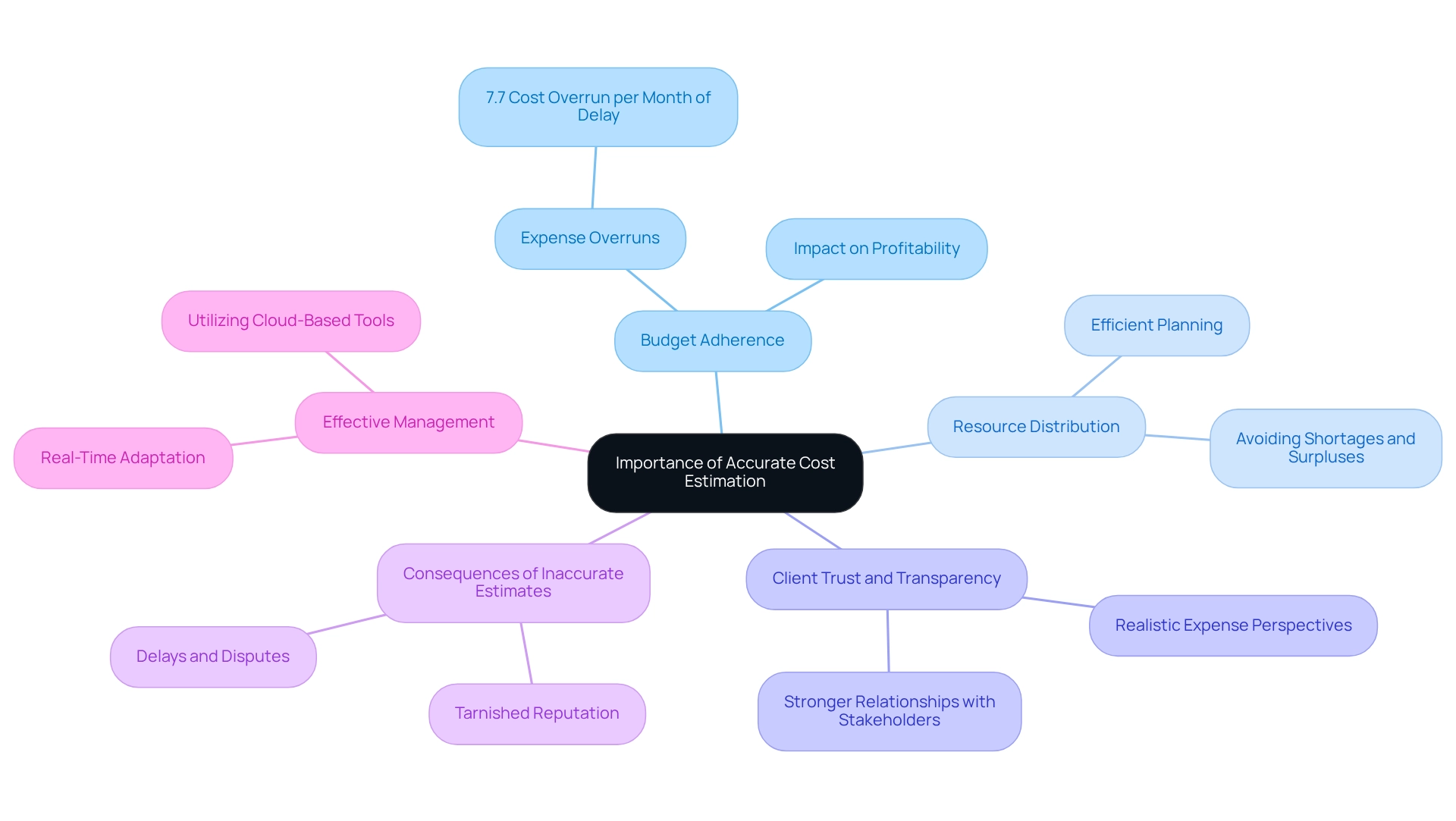
Exploring Different Cost Estimation Methods
In the construction sector, efficient cost estimation is vital for success. Various techniques are utilised, each customised to particular types and phases of projects. The most common methods include:
- Analogous Estimating: This method utilises the expenses of comparable previous projects to guide estimates for the present undertaking. It is particularly useful in the early stages when detailed information may be limited, allowing for quick assessments based on historical data.
- Parametric Estimating: Employing statistical connections between historical data and various variables, this technique computes estimates with a greater level of precision. It is increasingly favoured as contractors adopt advanced technologies, including AI and machine learning, to refine their estimations and improve risk assessments.
- Bottom-Up Estimating: This detailed method assesses the expenses of individual elements of an initiative and combines them to establish the overall expenditure. It is especially effective for intricate undertakings where accurate calculations are essential to prevent budget overruns.
- Top-Down Estimating: Beginning with an overall budget, this approach divides expenses into elements according to the requirements of the project. It is frequently utilised in the early stages of planning, offering a comprehensive summary of possible costs.
- Three-Point Estimating: This technique considers three scenarios, optimistic, pessimistic, and most likely costs, to provide a range of estimates. This approach aids in comprehending possible variations and preparing for unpredictabilities in project implementation.
Current trends show an increasing dependence on cutting-edge technologies, such as drones for site assessments, which enhance the effectiveness of cost estimation and improve the pace of financial forecasting procedures. These innovations are especially advantageous in large-scale operations, such as those carried out by Edmond Shipway. Furthermore, civil contractors are progressively concentrating on long-term objectives, such as attaining budget predictability and enhancing operational efficiency, by investing in automated estimation software and advanced technologies like AI, which are essential for effective cost estimation.
These advancements not only simplify workflows but also greatly improve financial precision and minimise delays in tasks.
As the building industry evolves, grasping the key distinctions between analogous and parametric estimating becomes crucial. While analogous estimating relies on historical data from comparable projects, parametric estimating employs statistical relationships to determine expenses, making it more adaptable to varying conditions. By mastering these techniques and keeping up with the latest trends, industry professionals can significantly enhance their budgeting practices related to cost estimation, ultimately leading to more successful outcomes.

Key Factors Affecting Cost Estimation
Accurate cost estimation in construction is influenced by several critical factors, each playing a vital role in determining the overall financial outcome of a project.
- Project Scope: A clearly defined project scope is essential for accurate budget estimation. When the scope is well-articulated, cost estimators can identify all necessary components and resources, leading to more accurate predictions. In contrast, any alterations or extensions in scope can lead to substantial expense increases, highlighting the necessity of comprehensive initial planning.
- Market Conditions: The construction industry is highly susceptible to fluctuations in market conditions. Fluctuations in material prices, influenced by supply chain dynamics and demand, can significantly affect overall expenses. Furthermore, labour availability and wage rates can vary depending on economic conditions, further complicating expense forecasts.
- Historical Data: Access to reliable historical data is invaluable for estimators. By examining previous projects, they can recognise trends and patterns that guide future expense forecasts. This data-driven approach enhances the accuracy of estimates, allowing for more informed decision-making.
- Labour Expenses: Labour expenses are a significant part of construction budgets. Variations in labour rates, shaped by local market conditions and the availability of skilled workers, can result in discrepancies in overall expenses. Understanding these dynamics is crucial for accurate budgeting.
- Regulatory Requirements: Adhering to local building codes and regulations can lead to extra expenses for a project. These requirements often necessitate specific materials, processes, or inspections, which can add to the overall budget. Staying informed about regulatory changes is essential for precise expense estimation.
- Experience and Skill Level of Estimators: The proficiency of estimators greatly influences the precision of financial predictions. Experienced estimators are better equipped to foresee potential issues and account for them in their estimates, leading to more reliable financial planning.
Along with these factors, the creation of a contingency fund is a suggested practice in the sector, usually varying from 5-10% of total building expenses. This fund acts as a financial cushion against unexpected costs, ensuring that initiatives stay on course despite unforeseen obstacles. Establishing such a fund is essential for reducing financial risks linked to building ventures.
Case studies, like the implementation of risk management in building projects, emphasise the significance of recognising and prioritising risk factors. This study highlights that the creation of a risk management process customised for different types of projects enables estimators to boost their decision-making abilities and enhance outcomes. A precise financial assessment is crucial for the success of any building project.
This proactive strategy not only reduces possible financial overruns but also encourages a more resilient framework.
In summary, grasping the varied factors affecting cost estimation in construction, ranging from scope to market conditions, provides professionals in the field with the tools needed for effective budgeting and financial planning.
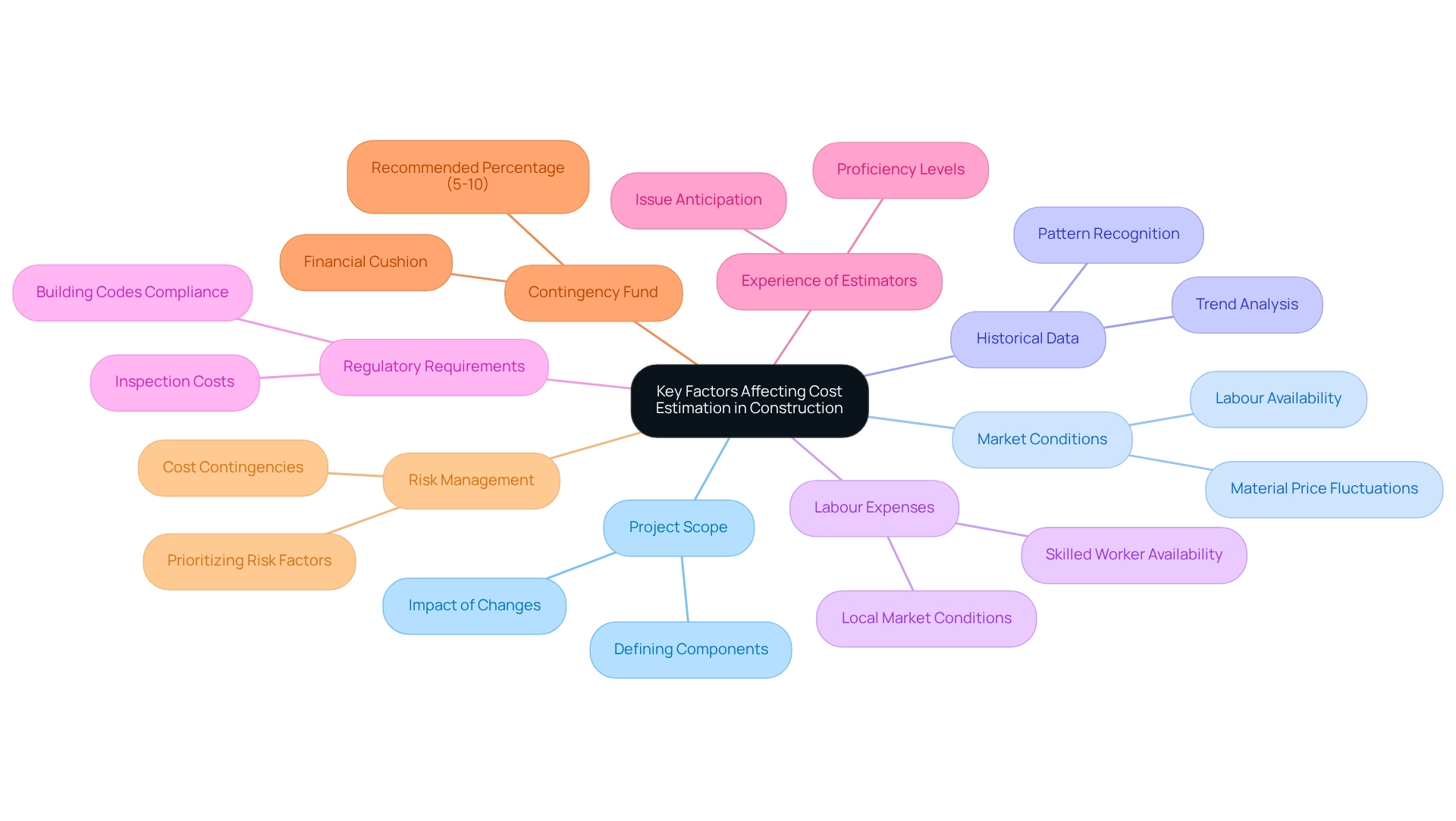
Common Challenges in Cost Estimation
Cost estimation in construction presents a myriad of challenges that can significantly impact project outcomes. Understanding these challenges is crucial for hospitality developers aiming to manage budgets effectively. Key issues include:
- Inaccurate Data: The reliance on outdated or incorrect data is a prevalent issue that can lead to substantial estimation errors. A study emphasised that the precision of financial estimates is significantly affected by the thoroughness of financial information and the competency of the estimator. Without accurate information, initiatives are at risk of financial discrepancies.
- Scope Creep: Adjustments in the scope of work are a frequent event in building, often leading to budget excesses. Research suggests that roughly 70% of building projects encounter scope creep, complicating initial estimates and disrupting financial planning. This underscores the significance of setting clear guidelines from the outset. A precise financial assessment, including cost estimation construction, is crucial for the success of any building project.
- Market Volatility: The construction sector is vulnerable to changes in material and labour expenses, making it difficult to offer precise estimates. For instance, recent trends show that prices for essential materials can vary significantly within short periods, necessitating continuous market analysis to adjust estimates accordingly.
- Time Constraints: Tight deadlines often pressure estimators to expedite their work, increasing the likelihood of errors. This haste can result in mistakes in calculations or the exclusion of essential financial elements, ultimately impacting the initiative’s fiscal well-being.
- Effective communication among stakeholders is vital for accurate cost estimation in construction, as communication gaps can create challenges. Misunderstandings can arise from unclear specifications or lack of information sharing, leading to discrepancies in estimates. Implementing digital solutions for managing tasks can enhance communication and mitigate these risks. A study indicates that to minimise rework in building, it is crucial to pre-select quality criteria, enhance communication among stakeholders, and adopt digital solutions for management.
Addressing these challenges requires a proactive approach, including the adoption of improved risk management practices and the use of technology to streamline communication and data accuracy. Edmond Shipway provides extensive construction advisory services that emphasise management, financial efficiency, and sustainability, which are crucial in addressing these challenges. The results from the case studies, highlight that clear and detailed drawings, the experience and skill level of the estimator, and the thoroughness of financial information are important elements in attaining precise estimates.
By concentrating on these aspects, hospitality developers can improve their budget assessment processes, ultimately resulting in more successful project results.
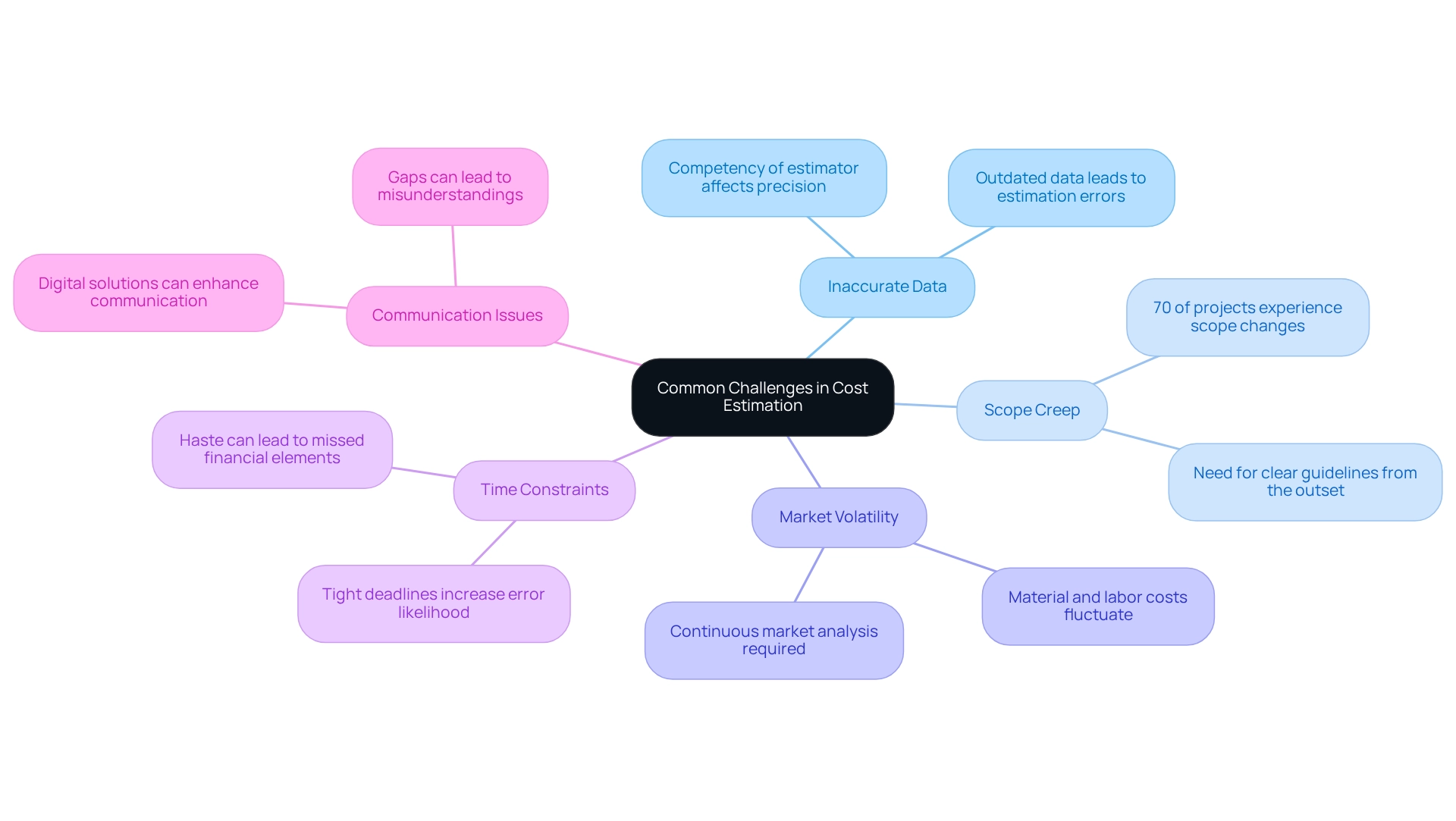
Best Practices for Effective Cost Estimation
To enhance the accuracy and efficiency of cost estimation in construction, adopting best practices is essential:
- Gather Accurate Data: Utilise current and relevant data to inform your estimates. Precise information serves as the foundation for dependable financial forecasts, significantly improving decision-making regarding resource distribution and risk management.
- Use Estimating Software: Implement advanced estimating software to streamline the estimating process. These tools not only minimise the potential for errors but also facilitate the integration of detailed quantity takeoffs, which are crucial for quantifying materials, labour, and equipment. Case studies from Edmond Shipway have shown that initiatives employing estimating software for cost estimation achieve higher success rates due to enhanced precision in financial assessment.
- Conduct Site Visits: Engage in site visits to gain firsthand insights that can inform more precise estimates. Understanding the specific conditions and challenges of the project location allows for improved predictions of potential expenses and resource requirements.
- Involve Stakeholders: Foster collaboration among team members and stakeholders throughout the estimation process. Incorporating diverse perspectives ensures that all potential expenses are accounted for, resulting in more thorough and precise estimates. Stakeholder involvement is crucial in identifying risks and opportunities that may not be immediately apparent.
- Review and Revise Estimates: Establish a system for assessing estimates against actual expenses. This practice not only aids in identifying discrepancies but also facilitates continuous improvement in future estimates. By learning from past projects, estimators can refine their approaches and enhance overall accuracy.
- Implement Strategies to Shorten Project Duration: Consider overlapping design and building activities where feasible. This approach can lead to more efficient timelines and improved overall results.
By applying these optimal methods, industry experts can significantly enhance the accuracy of their financial forecasts in cost estimation construction, ultimately leading to more successful outcomes. Precise quantity takeoffs, as demonstrated in Edmond Shipway’s case studies, are crucial for providing a reliable foundation for pricing analysis, assisting in preventing under or over-calculating expenses.
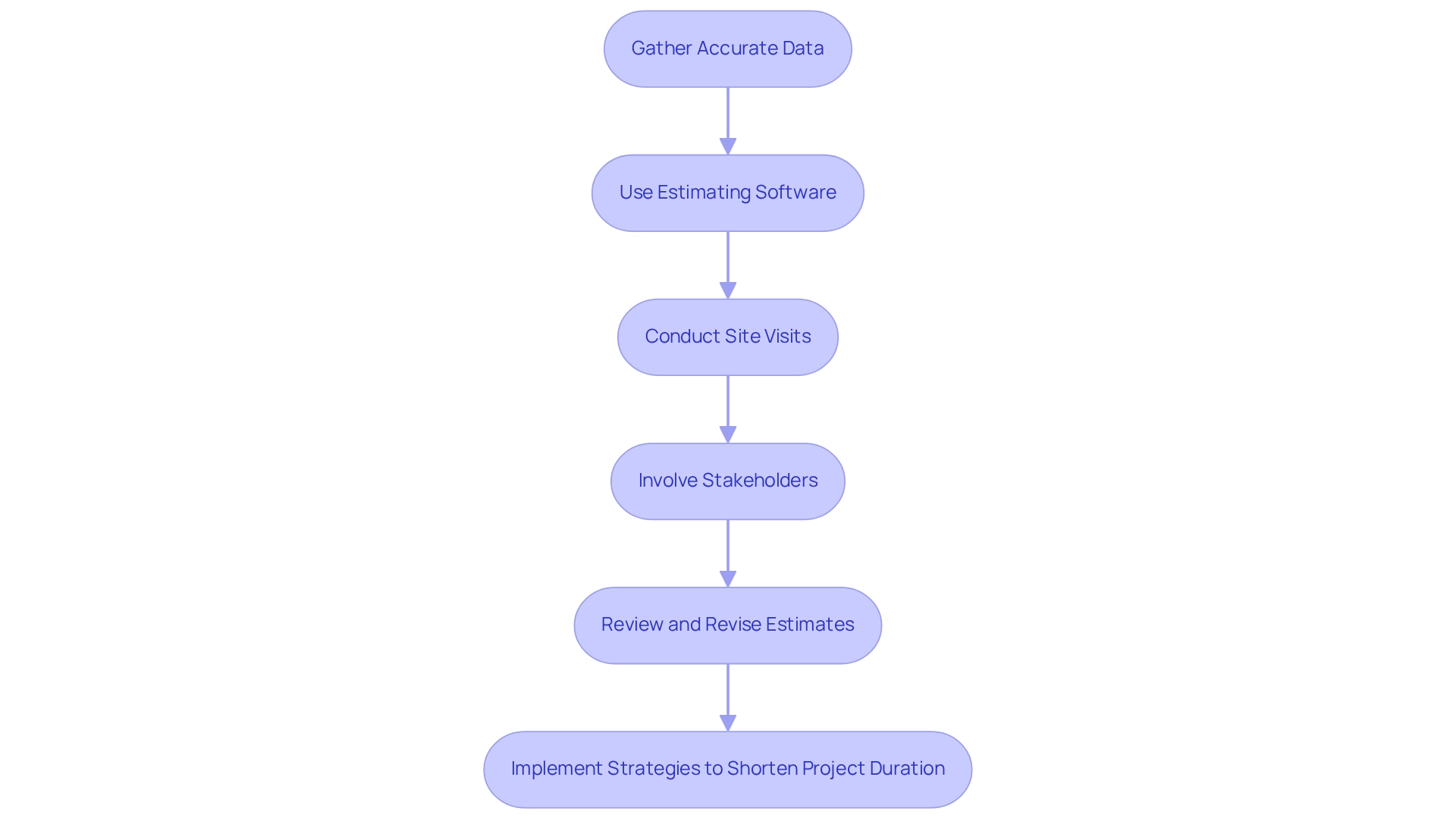
Leveraging Technology for Cost Estimation
Technology plays a pivotal role in enhancing cost estimation processes within the construction sector. This evolution is underscored by several key tools that exemplify how innovation is reshaping this vital aspect of project management.
- Estimating Software: Advanced programmes such as N3 are revolutionising the estimating landscape. These platforms facilitate swift computations and modifications, significantly reducing the time required for financial evaluations while improving overall accuracy. An investor aptly noted, “Some products require so much customisation that the software company becomes a consultancy,” which underscores the complexities involved in adopting these technologies.
- Building Information Modelling (BIM) is increasingly recognised as a transformative factor in cost estimation. By providing comprehensive visual representations of projects, BIM empowers estimators to grasp intricate project components, leading to more precise financial evaluations. Research indicates that utilising BIM can enhance cost estimation accuracy by as much as 20%, establishing it as an indispensable resource for construction professionals.
- Data Analytics: The integration of data analysis into pricing assessment processes enables firms to uncover trends and patterns in historical expenses. This analytical approach not only leads to more accurate cost estimations but also aids in forecasting future expenditures, thereby enhancing financial predictability.
- Mobile Applications: The advent of mobile technology has equipped estimators with the ability to access critical data and execute calculations directly on-site. This capability not only enhances efficiency but also ensures that estimates reflect real-time conditions, further bolstering accuracy.
- 4D Simulations are instrumental in assisting project managers to anticipate bottlenecks and optimise workflows, which is essential for refining cost estimation processes.
As the construction sector evolves, embracing these technological innovations is imperative for achieving operational effectiveness and refining cost estimation practices. The ongoing trend toward automation and the integration of AI in estimating software reflects a broader shift aimed at improving financial forecasting and minimising project delays. Contractors are increasingly investing in automated assessment software and cutting-edge technologies like AI to enhance financial precision and operational efficiency, particularly in the realm of cost estimation.
Furthermore, the growing demand for building software development is exemplified by Intellectsoft’s emergence as a key partner in this domain, highlighting the importance of adopting new technologies. By leveraging these tools, construction companies can navigate the complexities of cost estimation with greater confidence and accuracy.
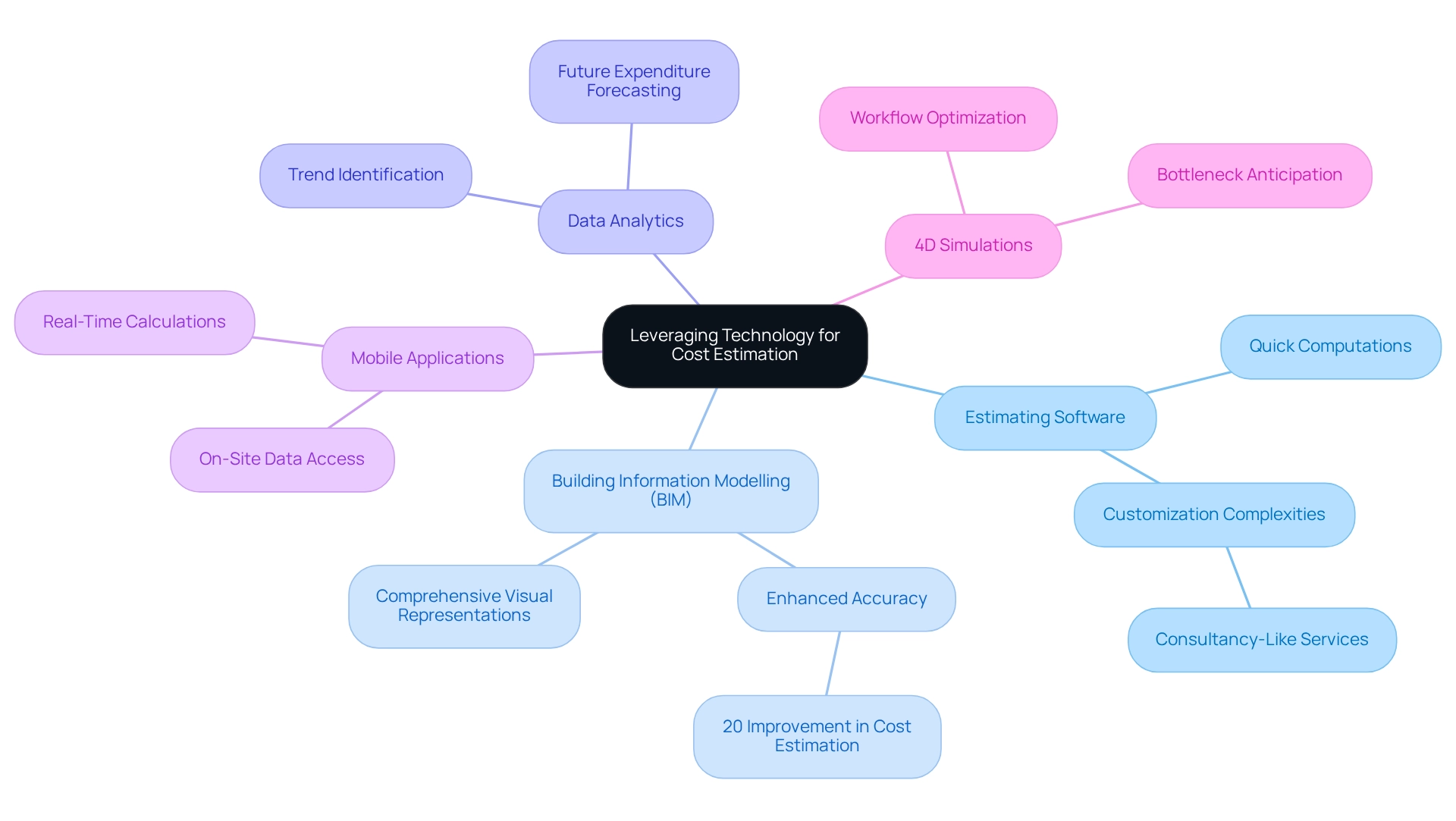
Step-by-Step Guide to Creating a Cost Estimate
Creating a cost estimation in construction is a critical process that involves several essential steps to ensure accuracy and reliability.
- Review the Scope: Begin by thoroughly understanding the full extent of the undertaking. This includes identifying all necessary components, such as design specifications, timelines, and regulatory requirements, which are crucial for an accurate estimate.
- Conduct a Site Visit: A site visit is vital for assessing the actual conditions of the location. This allows estimators to gather relevant data, such as topography, accessibility, and existing infrastructure, which can significantly influence costs.
- Perform a Material Takeoff: This step involves listing all materials required for the project along with their quantities. A detailed material takeoff helps in identifying potential cost-saving opportunities and ensures that no essential items are overlooked.
- Pricing: Reach out to suppliers and subcontractors to obtain current pricing for materials and labour. This step is crucial for ensuring that the cost estimation reflects the most precise and current expenses, which can vary according to market conditions.
- Determine Expenses: Add the expenses of materials, labour, overhead, and contingencies to reach a total estimate. In cost estimation, it is essential to incorporate a buffer for unexpected costs, as building projects frequently face unanticipated obstacles.
- Review and Adjust: Finally, compare the estimate against historical data and adjust as necessary. This evaluation procedure is essential for guaranteeing precision and may include examining previous projects to recognise patterns and possible inconsistencies.
In 2025, the typical duration required to produce a thorough financial estimate in construction projects is roughly 3 to 4 weeks, depending on the project’s complexity.
A case study on a sewage treatment facility demonstrates the significance of accounting for different financial factors and locational indices. The analysis disclosed that expenses related to site preparation and adherence to environmental standards significantly influenced the overall cost estimation, highlighting the necessity for comprehensive planning and assessment. This case study acts as a practical illustration of how various elements can affect pricing assessments in real-life situations.
By adhering to these steps and utilising expert knowledge, hospitality developers can achieve accurate cost estimation that not only reflects the actual expenses of their projects but also contributes to favourable results.
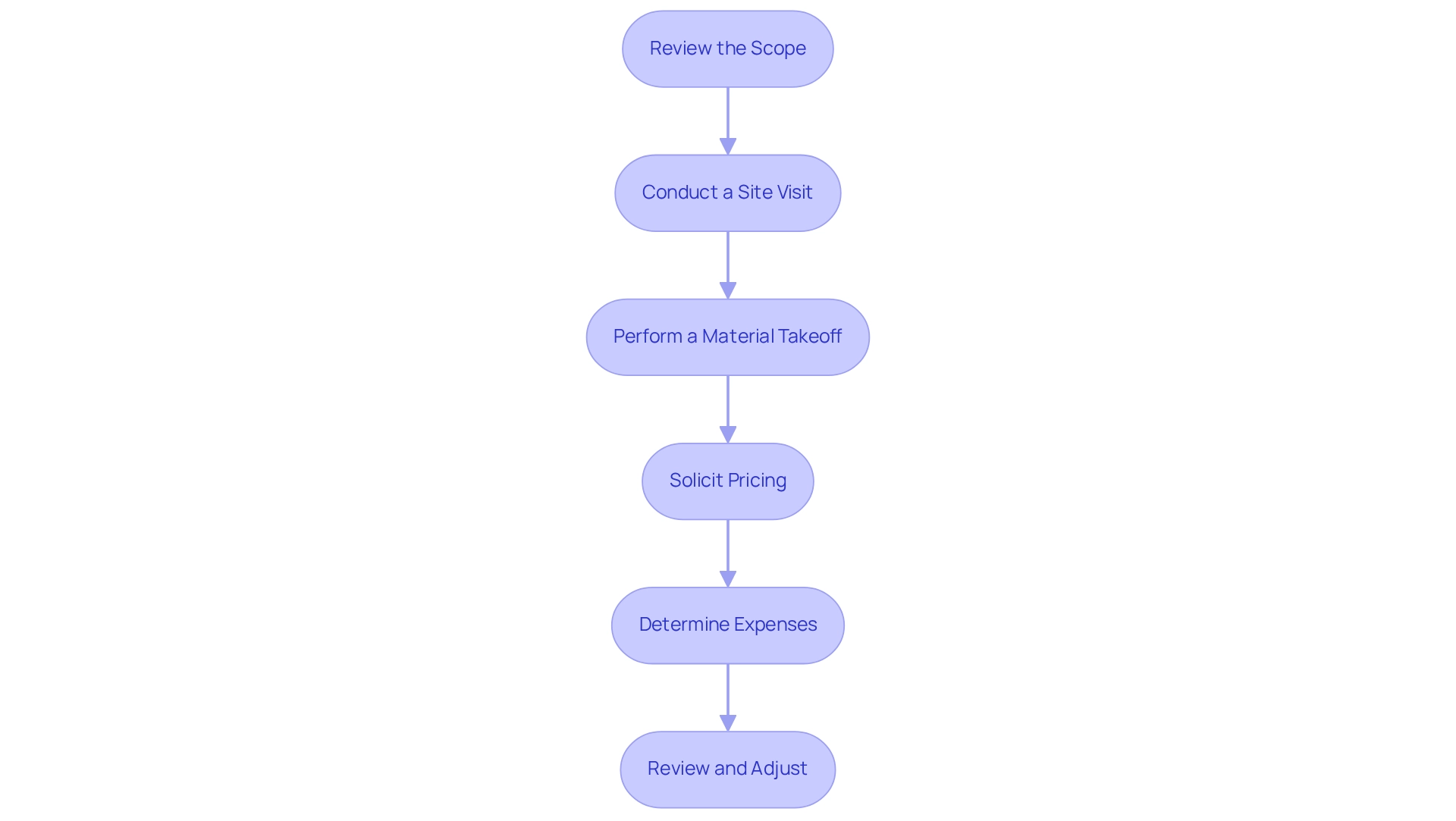
Continuous Improvement in Cost Estimation Practices
Ongoing enhancement in cost estimation construction methods is essential for adjusting to changing market conditions and demands. To cultivate a culture of enhancement, consider the following strategies:
- Regularly Review Estimates: Conduct thorough analyses of past estimates compared to actual expenses. This practice not only highlights discrepancies but also uncovers valuable insights that can inform future cost estimation construction. Ultimately, this leads to more accurate budgeting and financial management.
- Solicit Feedback: Actively gather input from team members and stakeholders engaged in the assessment process. Their perspectives can reveal inefficiencies and suggest refinements, ensuring that the estimating process is both collaborative and responsive to real-world challenges.
- Stay Updated on Trends: Keeping abreast of industry trends and technological advancements is crucial. For instance, the integration of advanced software tools can significantly enhance estimating accuracy, allowing for more precise calculations that reflect current market conditions.
- Invest in Training: Ongoing training for estimators is essential to equip them with the latest skills and knowledge. Studies show that companies that emphasise training experience a significant enhancement in budgeting precision, resulting in improved project results and higher client satisfaction.
Integrating these practices not only encourages a proactive method to expense estimation but also aligns with the principles of ongoing enhancement discussed in recent literature, such as the book ‘Continuous Expense Improvement in Construction’. By systematically reviewing estimates, soliciting feedback, staying informed about industry developments, and investing in training, professionals in the building sector can enhance their processes for cost estimation construction. Additionally, understanding the classification of construction cost estimates into design estimates, bid estimates, and control estimates provides a more comprehensive understanding of their roles in the project lifecycle, ultimately leading to more successful project execution.

Conclusion
Accurate cost estimation stands as a cornerstone of successful construction project management, influencing everything from budget adherence to client satisfaction. Understanding various cost estimation methodologies, such as analogous, parametric, and bottom-up estimating, is crucial. Each method serves a unique purpose, tailored to specific project requirements. Moreover, leveraging technology like Building Information Modeling (BIM) and advanced estimating software enhances both accuracy and efficiency.
Key factors affecting cost estimation, including project scope, market conditions, and estimator expertise, play a pivotal role in shaping reliable estimates. Challenges such as data inaccuracies and scope creep underscore the necessity for proactive measures to mitigate risks associated with cost overruns. By implementing best practices, gathering accurate data, involving stakeholders, and utilising modern technology, construction professionals can significantly improve their estimation processes.
The journey toward mastering cost estimation is ongoing, requiring continuous improvement and adaptation to the evolving landscape of the construction industry. Embracing a culture of learning and leveraging innovative tools empowers stakeholders to navigate the complexities of financial forecasting with greater confidence. Ultimately, accurate cost estimation not only safeguards project budgets but also builds trust with clients, ensuring long-term success in the competitive construction sector.
Share


